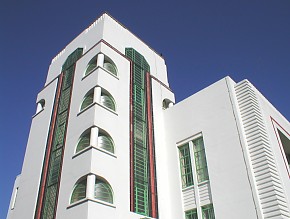|
|
 |
|
Ealing
|
 |
|
An industrial and residential area in east Greenford, bounded by the River Brent and the Paddington branch of the Grand Union
Canal. Perivale was originally Greenford Parva, or Little Greenford, and the name may be a corruption of Parva. Alternatively
it may derive from ‘pure vale’ or ‘pear vale’. Stories have been told of a sequence of mysterious
deaths at the medieval Perivale Mill, but there is little documentary evidence even for the mill’s existence. The manor
of Perivale evolved in the late Middle Ages, with links to the Mercers’ Company of the City of London. The manor house
was demolished by 1850. Perivale remained very quiet into the early years of the twentieth century. The station opened in
1904 but the village still had fewer than 100 inhabitants by the time of next census. The availability of open land and the
coming of the Western Avenue brought industry after 1930, such as Sanderson’s wallpaper factory. Residential estates
followed, notably Perivale Park, built to the west of the station by Cliffords Estates, who boasted of its twenty different
styles of elevation. Developments to the north of the industrial area included local shops on Bilton Road. By 1951 Perivale’s
population had risen to almost 10,000. Just over half the residents of Perivale are white and the largest minority is of Indian
descent. In most respects, Perivale’s socio-economic profile is representative of the borough as a whole, but a little
more affluent. Perivale Wood is an ancient woodland formerly known as Braddish Wood, and privately owned by the Selborne Society.
This is the second oldest nature reserve in the country but is not generally open to the public.
|
 |
|
|
|
 |

|
| Delightful art deco detailing suffuses every corner of the Hoover building |
Undoubtedly Perivale’s architectural highpoint
is the Hoover building. “One of these days the Hoover factory’s gonna be all the rage / In those fashionable pages,”
prophesied Elvis Costello in 1978. This art deco masterpiece by London-based architects Wallis, Gilbert & Partners was completed
in 1933. It closed in 1982 and reopened ten years later – magnificently restored, with the rear of the building converted
into a Tesco superstore.

|
 |
|
|
|
|
|
Postal district: Greenford, UB6
Population: 13,441
Station: Central Line (Zone 4)
Further reading: Frances Hounsell, Greenford, Northolt and Perivale Past, Historical Publications, 1999

Text and selected images are reproduced with the permission
of Chambers but may differ from the published versions
All content © 2005–2010
|
|
|
 |

